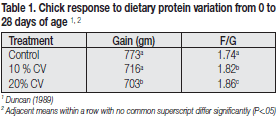Ensuring Optimum Mixability In Feed Manufacturing: Part 2 - Effect Of Mixing Uniformity On Animals P

Effect Of Mixing Uniformity On Animals Performance
Uneven ingredient dispersion feeds may lead to reduced bird performance. In order for birds to reach their genetic potential for growth and meat yield, levels of protein, energy vitamins and minerals must be provided in their proper ratio. Duncan (1989) reported that as protein variation increased in feeds, growth rate and feed conversion were depressed (Table 1). A 10% variation in the feed quality significantly reduced both weight gain and increased feed conversion. When the coefficient of variation (CV) of the feed was increased to 20%, another significant increase was observed in feed/gain (F/G).

A recent study on the effect of mixing uniformity on day one old broilers was conducted by McCoy et al. (1994). Feed was formulated to meet or exceed NRC requirements for all nutrients for broiler chicks from 0 to 3 week of age. However, in experiment 2, feeds were formulated to 80% of NRC recommendations for crude protein (CP), lysine, methionine, Ca, and P. The purpose of using deficient diet in this study was to accentuate any difference in growth performance that might result from diet nonuniformity.
In experiment 1, feeds were collected from mixer after 20, 40 and 80 revolutions of mixing (20 = highly non-uniformity mixing, 40 = moderate nonuniformity mixing and 80 = uniform mixing). Variability of feed decreased sharply between 20 and 40 revolutions and no further reduction occured between 40 and 80 revolutions (Table 2). The CV values from analyses of salt concentrations were 43, 11 and 13% for 20, 40 and 80 revolutions, respectively. No difference occured among treatment for average daily gain (ADG), average daily feed intake (ADFI), bone strength, bone ash, carcass crude protein, carcass fat, or carcass ash. However, there was a trend for a linear increase in gain:feed (G/F) ratio when mixer revolutions were increased.
In experiment 2, feeds were collected after 5, 20, and 80 revolutions. The salt test CV % decreased from 40.5% to 12.1% when mixing was increased from 5 to 20 revolutions, but there was no further reduction of CV % from 20 to 80 revolutions (Table 3). ADG, ADFI and G/F improved when CV % decreased from 40.5 to 12.1%. However, mortality was not affected by treatment.
The effect of poorly mixed feed on pig performances was reported by Traylor at el. (1994). In this experiment the effect of mix time on diet uniformity and growth performance was evaluated in nursery and finishing pigs on a double-ribbon mixer.
For the nursery experiment, increasing mix time from 0 to 0.5 min decreased the CV % from 106.5 to 28.4% (Table 4). Increasing mix time to 4 min reduced CV value to 12.3%. ADG, F/G and ADFI was increased by 49, 19 and 20 %, respectively as the CV for marker concentration decreased from 106.5 to 12.3%.
For the finishing experiment, increasing mix time reduced the CV for diet uniformity from 54 to less than 10 % (Table 5). The mix time had no statistically significant effects on ADG, ADFI, F/G and bone strength. However, rate and efficiency of gain had numerical increases of 4 and 5 %, respectively, as mix time increased from 0 to 0.5 min.
They concluded that that increased mix time improved diet uniformity and performance of nursery pigs. Finishing pigs were less sensitive to diet nonuniformity, with growth performance being affected only slightly as mix time was increased from 0 to 4 min. The finishing pigs were quite tolerant of CVs of at least 15% and even up to 54%. However, caution is warranted when using a medicated feed article.
Ensuring Optimum Mixability In Feed Manufacturing: Part 3 - Factors That Affect Mixer Performance
Ensuring Optimum Mixability In Feed Manufacturing: Part 4 - Mixer Testing
Ensuring Optimum Mixability In Feed Manufacturing: Part 5 - Color-coded Tracers, Data Analysis
Ensuring Optimum Mixability In Feed Manufacturing: Part 6 - Conclusion




